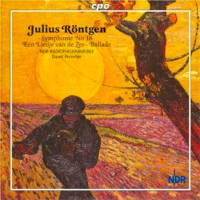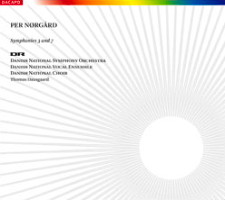
Sacrificing the 'unmodern'
Music by Julius Röntgen
and Per Nørgård -
heard by
GEORGE BALCOMBE'How could any audience resist ... ?'
|

|
This review features two composers -- Julius Röntgen (JR), who died on this day in 1932 and Per Nørgård (PN), who was born in 1932.
JR began his music career as a child prodigy in Leipzig, where his violinist father was concertmaster in the Gewandhaus. At twenty three, JR went to live in Amsterdam, where in 1913 the former prodigy became director of the city's Royal Conservatory.
JR's musical legacy consists of some six hundred scores, of which this review's first CD has four orchestral works. They are 1) Symphony No 18 (1931), 2) Ballade on a Norwegian Folk Song (1900), 3) Sea-Song on a Dutch Folk Song (1902), and 4) Six Old Dances from the Antwerp publisher and composer Tielman Susato (1551).
All these are played superbly on this CD by the North German Radio Philharmonic conducted by David Porcelijn.
The CD booklet points out that Symphony No 18 is 'classical and long when compared with the eight symphonies from 1930', plus three from the spring of 1931, and 'moreover it is written in the traditional four movements'.
Well, it would be, wouldn't it? Leipziger and former prodigy endowed with the DNA of the Gewandhaus' erstwhile director, Felix Mendelssohn, was unlikely to jettison his inheritance. It has been fascinating in the 2009 BBC Proms to hear various orchestras (not excluding, as it happens, the Leipzig present-day Gewandhaus players themselves), resounding with JR-like sounds. For example, this CD's most beautiful passage is the Symphony No 18's Passacaglia second movement.
Listen -- Röntgen: Andante mesto (Symphonie No 18 in A)
(cpo 777 255-2 track 2, 0:02-1:09) © 2008 CPO
A short third movement follows with a perfect woodwind scherzo, not copying the Mendelssohn of A Midsummer Night's Dream, but identifying with him.
The Symphony No 18 was composed in a single day. Its orchestration took a little longer -- just over two weeks, but then, of course, JR was a busy man with many other musical activities. He maintained that he would rather be composing more than doing anything else. This may have been fantasy rather than fact because he had, since his Leipzig days, been a professional concert pianist, as soloist, accompanist and participant in chamber ensembles. In his last years he conducted his own works besides two of Amsterdam's important choirs.
Another activity which he constantly pursued was collecting Dutch folk songs and other old music and he earned recognition as Holland's leading activist in orchestral and choral transcription of Dutch folk music.
JR's skill to compose and score Symphony No 18 for two pianos in one day illustrates his absorption and adherence to his early Leipzig education. He did not have to think about Symphony No 18 but only to write it. In a sense, this rapid pouring out of works by the hundred emulated leading composers of the seventeenth and eighteenth centuries.
The Norwegian Ballade is wordless. The orchestra alone unfolds the tragedy. Clarinets begin and end the Ballade with the plaintive melody of the Norwegian song which is gradually transformed into gigantic cumuli of climax. The sound is not trivialised by decorative variations.
Listen -- Röntgen: Ballade über eine norwegische Volksmelodie
(cpo 777 255-2 track 5, 12:28-14:12) © 2008 CPO
This is JR's genius with orchestration. The orchestral Ballade is tragedy. The climax dissolves and the clarinets reach the conclusion. There is dissolution and, finally, silence.
JR prepared a two piano score and played it in Vienna with his friend Brahms who, impressed, subsequently got his publisher Simrock, to include the Norwegian drama in the firm's list.
In complete contrast, JR transcribed the old and popular Dutch Sea Song, which confronted JR with its French history from the 1500s, which also appeared in the 1600s as theme and variations arranged by the Netherlands organist/composer Sweelinck.
The tune is bright and the lyric no less so. JR's charming depiction of a small sailing boat off to seek a sea fortune has the orchestra strings at their sweetest, slowly rocking like the swell. As we get carried away by the calm sea and, hopefully, a prosperous voyage, it suddenly dawns on us that this Sea Song is another theme and variations.
In 1921, when asked to describe his own compositions, JR simply said 'unmodern'. He certainly did not exclude music from 1551 published by the Antwerp Tielman Susato in the series of dances entitled Danserije. How could any audience resist the attraction of six dances labelled Salterelle, Branle de Bourgogne, Ronde, Gaillarde La Brune, Bergerette. Les grands bouleurs and Pavane-Lesquercarve.
Listen -- Röntgen: Pavane. Lesquercarve (Old Netherlandish Dances)
(cpo 777 255-2 track 12, 1:34-2:25) © 2008 CPO
JR could certainly not resist such a collection, and duly transcribed six of the pieces printed in 1551. Today, the dances would be classified as Early Music, played by Authentic Instruments. But ironically, without realising his predicament, JR had to sacrifice his usual 'unmodern' stance for 1900s 'modern' in the form of Amsterdam's Concertgebouw Orchestra. Happily, JR's energetic version of the dances is the one heard on this CD and he can almost be forgiven for being born too late for today's Early Music and Authentic Instruments.

Because Per Nørgård was not born until 1932, he lived in a different musical world which changed beyond recognition after World War II. In Germany, not a million miles from Leipzig, institutions such as Darmstadt established the new musical world on the ruined remains of the old.
Like many of his generation, PN studied and experimented, not only with new music but with new technology that made it possible. That old-fashioned master of everything and anything serial, Schoenberg, soon found himself faced with such subtleties as microtonality and electronic devices designed to destroy everything remotely diatonic.
Listen -- Nørgård: I (Symphony No 3)
(6.220547 track 1, 1:00-2:52) © 2008 Dacapo Records
PN, however, was Scandinavian, and even in the perilous 1960s he remained transfixed by the then fashionably despised Sibelius. The young PN regarded his famous Finnish hero as creator of the 'greatest innovations in musical form ... especially in the relationship between the details and the overall form'.
During World War I the Danish composer Carl Nielsen wrote his devastating Symphony No 4 during 1915-16, the uudslukelige -- the Inextinguishable Symphony with its incessant percussion simultaneously hammering out hope and hopelessness.
From his Symphony No 1 onwards the twenty-three-year-old PN mastered the post-World War II devices and sounds but by his 1975 Symphony No 3 he had turned again to his Scandinavian musical instincts which, for him thereafter, meant the two inextinguishable composers Sibelius and Carl Nielsen. Both were natives of the North like himself.
Here, Symphony No 3 is given a sparkling performance by the Danish National Symphony Orchestra, the Danish National Vocal Ensemble and the Danish National Choir conducted by Thomas Dausgaard.
Listen -- Nørgård: I (Symphony No 7)
(6.220547 track 3, 0:00-1:14) © 2008 Dacapo Records
PN's Symphony No 7 (for orchestra alone) had its first triumphant performance on 29 January 2009 with a tumultuous response in Copenhagen's new concert hall.
Before giving a detailed analysis of PN's Symphonies Nos 3 and 7, the CD booklet makes the significant observation that PN's symphonies are 'milestones, summations at intervals of several years ... clarifications of new possibilities and new paths in PN's musical universe'. In defiance of post-World War II's bare technology PN 'still maintains and develops the symphony as a genre'.
Intense concentration is necessary when listening to this CD's Symphonies Nos 3 and 7. But as the 2009 first performance audience demonstrated, the indescribable ancient Scandinavian force unleashed by PN is all that matters.
Listen -- Nørgård: III (Symphony No 7)
(6.220547 track 5, 8:04-9:54) © 2008 Dacapo Records
Curiously, JR was, from the age of eleven, drawn to Norway and, later, specifically to the mystery-making Edvard Grieg. He and JR became particular friends, taking ferries to and from Norway and Holland. When Grieg died in 1907, JR made a special gesture towards his friend of twenty four years, and published Grieg's unpublished work. In 1930, two years before his own death, JR's biography of Grieg came out.
It was not in Leipzig that the child prodigy died, but in a Utrecht house near the shores of his beloved North Sea.
But there was another link between JR and Scandinavia. He and some or all of his four Danish-speaking musician sons often went to Denmark where JR met another of his composer friends, Carl Nielsen, who died in 1931, a year before JR and a year before his fellow Dane, PN, was born.
Twenty years later, PN had begun to write his powerful symphonies. Although JR had never thought much of 'modern' music, he would have been proud of the young composer who thought Carl Nielsen belonged to an ancient Scandinavia, as did Grieg, Sibelius and PN himself.
Copyright © 13 September 2009
George Balcombe,
London UK
 CD INFORMATION: JULIUS RÖNTGEN SYMPHONY NO 18
CD INFORMATION: PER NØRGÅRD SYMPHONIES 3 AND 7
CD INFORMATION: JULIUS RÖNTGEN SYMPHONY NO 18
CD INFORMATION: PER NØRGÅRD SYMPHONIES 3 AND 7
| 
